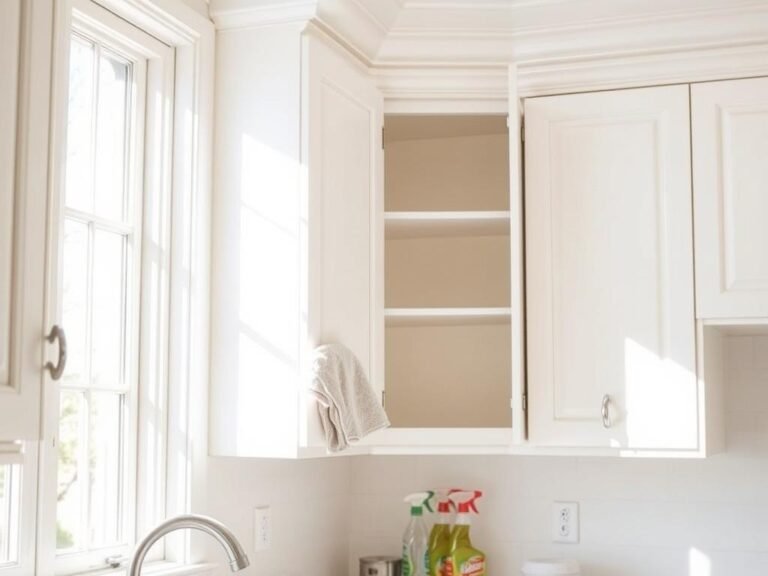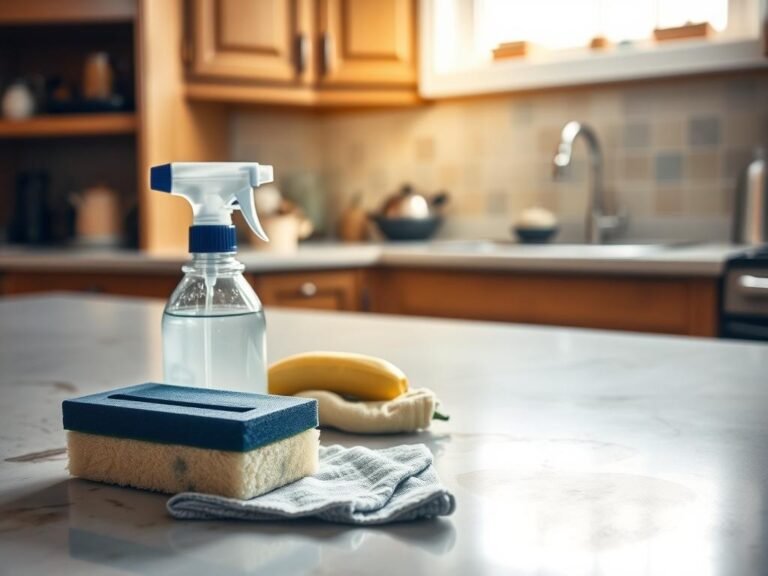White cabinets are a timeless choice for any home, adding brightness and elegance to your space. Their ability to reflect light makes kitchens feel more open and inviting, while their clean look enhances overall organization1. Regular maintenance is key to preserving their beauty and ensuring they remain a focal point in your home.
Keeping these surfaces spotless doesn’t have to be complicated. Simple tools like a microfiber cloth and gentle solutions can make a big difference. For tougher stains, natural options like vinegar and baking soda are effective and safe2. By incorporating these methods into your routine, you can extend the lifespan of your cabinets and maintain their pristine appearance.
We’re here to guide you through the process, from daily upkeep to deeper cleaning techniques. Let’s work together to create a brighter, cleaner kitchen that you’ll love spending time in.
Key Takeaways
- White cabinets enhance brightness and create a spacious feel in kitchens.
- Regular maintenance prevents long-term damage and preserves their appearance.
- Microfiber cloths and gentle solutions are ideal for daily cleaning.
- Natural cleaners like vinegar and baking soda tackle tough stains effectively.
- Preventive measures, such as using exhaust fans, reduce grease buildup.
Introduction and the Value of Pristine White Cabinets
The allure of white cabinetry lies in its ability to transform any space into a bright, welcoming haven. Its timeless appeal and versatility make it a favorite among homeowners, blending seamlessly with various design styles3. Whether your kitchen is modern or traditional, white surfaces create a sense of openness and elegance that’s hard to match.
Beyond aesthetics, maintaining these surfaces offers practical benefits. Regular upkeep prevents stains and grease buildup, ensuring your cabinets stay in top condition4. Simple tools like a damp cloth and natural solutions such as vinegar and baking soda can work wonders. These methods are not only effective but also eco-friendly, making them a smart choice for any household.
Why White Cabinets Enhance Your Home
White cabinetry reflects light, making even smaller kitchens feel more spacious and airy. This design choice also adds value to your home, appealing to modern buyers who appreciate a clean, professional look5. Its ability to conceal minor imperfections makes it a practical option for busy households.
Overview of Cleaning and Maintenance Benefits
Keeping your cabinets pristine doesn’t require complex routines. Regular wiping with water and mild solutions helps maintain their appearance. For tougher stains, a mix of vinegar and baking soda can restore the surface without harsh chemicals4. Preventive measures, like using exhaust fans, reduce grease accumulation and protect your investment.
By incorporating these practices, you can enjoy the beauty and functionality of white cabinetry for years to come. Let’s explore how simple steps can make a big difference in your kitchen’s overall appeal.
Everyday Cleaning Tips and Preventive Routines
Simple daily habits can keep your surfaces looking fresh and spotless. Regular maintenance not only preserves the finish but also prevents long-term damage. By dedicating a few minutes each day, you can avoid the buildup of dust, grease, and stains6.

Quick Wipe-Downs and Spot Cleaning
Using a microfiber cloth for quick wipe-downs is an effective way to remove dust and handprints. For small spills, a lightly dampened cloth works wonders. Spot cleaning stubborn marks with a mix of vinegar and baking soda can restore the surface without harsh chemicals7.
Here’s a simple routine to follow:
- Wipe surfaces daily with a dry or damp cloth.
- Address spills immediately to prevent stains.
- Use natural solutions like vinegar and baking soda for tougher marks.
Tools You’ll Need
Having the right tools on hand makes the process easier. Essential items include:
- Microfiber cloths for gentle cleaning.
- Soft sponges to avoid scratching the finish.
- Mild detergents or natural solutions like vinegar and baking soda.
Regular cleaning at proper intervals protects the surface from grease and moisture buildup. Incorporating these habits into your routine ensures your cabinets stay in top condition for years to come6.
how to clean white kitchen cabinets
Maintaining the pristine appearance of your surfaces requires a systematic approach. By following a structured process, you can ensure your space stays fresh and inviting. Let’s break down the steps for both regular upkeep and tackling stubborn stains.

Step-by-Step Cleaning Process
Start by removing dust and debris using a microfiber cloth. This prevents scratches and prepares the surface for deeper cleaning8. Next, prepare a gentle cleaning solution by mixing one part dish soap with two parts warm water. This mixture effectively removes grease without damaging the finish9.
Dip a soft sponge into the solution and wring it out to avoid excess moisture. Wipe down the surfaces in smooth, even motions. Pay special attention to handles and edges, where grime tends to accumulate. Finally, dry the area with a clean cloth to prevent water spots.
Deep Cleaning Techniques for Stubborn Stains
For tougher stains, create a paste using baking soda and water. Apply it to the affected area and let it sit for 10-15 minutes. Gently scrub with a soft-bristled toothbrush to lift the stain without scratching the surface9.
Rinse with a damp cloth and dry thoroughly. This method is particularly effective for removing grease buildup in hard-to-reach corners. Regular deep cleaning ensures your white cabinets maintain their bright look over time8.
By incorporating these techniques into your routine, you can keep your white kitchen looking its best. Proper care and attention will preserve the beauty and functionality of your space for years to come.
DIY Cleaning Solutions and Natural Methods
Natural cleaning solutions are a game-changer for maintaining pristine surfaces. These methods are not only effective but also safe for your family and the environment. By using common household items, you can create powerful mixtures that tackle grime and grease without damaging the cabinet surface10.

Effective Vinegar, Baking Soda, and Dish Soap Mixtures
One of the most popular DIY solutions combines vinegar, baking soda, and dish soap. This mixture is gentle yet potent, making it ideal for regular maintenance. Here’s how to prepare it:
| Ingredient | Quantity | Purpose |
|---|---|---|
| Vinegar | 1 cup | Disinfects and removes stains |
| Baking Soda | 1 tablespoon | Acts as a gentle abrasive |
| Dish Soap | 1 tablespoon | Cuts through grease |
| Warm Water | 2 cups | Dilutes the solution |
Mix these ingredients in a spray bottle for easy application. This solution is perfect for wipe cabinet surfaces and handles, leaving them spotless and streak-free11.
Using Microfiber Cloths and Gentle Tools
To avoid scratches, always use a microfiber cloth for cleaning. These cloths are non-abrasive and effectively trap dust and dirt. For tougher stains, a soft sponge or toothbrush can be used to apply a baking soda paste directly to the affected area12.
Regular maintenance with these tools ensures your surfaces stay in top condition. By adopting these eco-friendly practices, you can reduce the need for harsh chemicals and keep your space looking its best10.
Preventive Measures and Long-Term Cabinet Care
Preserving the beauty of your space starts with proactive care and smart habits. By adopting preventive measures, you can protect your surfaces from damage and keep them looking fresh for years13. Let’s explore practical strategies to minimize wear and tear while maintaining their natural luster.

Minimizing Grease and Grime Accumulation
Grease and grime are common culprits that can dull your surfaces over time. One effective tip is to use a range hood while cooking. This reduces airborne grease particles that settle on your surfaces14.
Regular wipe-downs with a microfiber cloth and a gentle dish soap solution can prevent buildup. Spot cleaning spills immediately also helps avoid stubborn stains13. Here’s a quick guide to follow:
| Step | Action |
|---|---|
| 1 | Wipe surfaces after cooking |
| 2 | Use a range hood to reduce grease |
| 3 | Spot clean spills immediately |
Avoiding Common Cleaning Mistakes
Using abrasive tools or excessive moisture can harm your surfaces. Always opt for soft sponges or microfiber cloths to avoid scratches14. Avoid harsh chemicals like bleach, which can damage the finish15.
Another common mistake is neglecting regular inspections. Checking for wear or damage helps address minor issues before they escalate14. Here’s a summary of do’s and don’ts:
- Do: Use gentle dish soap and soft tools.
- Don’t: Over-saturate surfaces with moisture.
- Do: Inspect regularly for signs of wear.
- Don’t: Use abrasive cleaners or tools.
By following these tips, you can maintain the beauty and functionality of your space. A little effort today ensures a brighter, cleaner tomorrow13.
Conclusion
Keeping your space fresh and inviting is easier than you think. By adopting simple routines, you can maintain its beauty and functionality. Regular cleaning with a vinegar and water mixture prevents buildup and keeps surfaces spotless16.
Acting quickly on spills is crucial to avoid long-term damage. A baking soda paste works wonders for stubborn stains, restoring the finish without harsh chemicals17. These natural solutions are safe and effective for daily use.
Consistency is key. A few minutes each day can make a big difference. Weekly wipe-downs and monthly deep cleans ensure your home stays pristine16. Share your success stories and tips with us—we’re here to help you create a cleaner, more inviting space.




